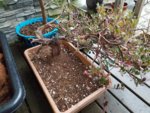I thought they were extremely sensitive to having their roots disturbed.
@Arcto has kept several alive.
When we developed our acreage we purchased 250 Kinnickinnik plugs from a nursery that propagates native plants to our area. To plant on the hillside for serosion protection. Watered them in and came back the next day. The deer decided to check them out and pulled most of them up, did not eat them just pulled them up. We replanted them and put down deer repellant ( blood meal ) in the area.
They mostly all survived and they propagate faster than rabbits, producing roots wherever they touch the ground for long in our climate. Similar to ground cover creeping style junipers. Sandy, gravelled type soil, south facing slope full sun. They make an amazing ground cover!
Cannot speak for collection or trying to raise in a pot with different soil combinations.
I would suspect the key would be free draining , drier and sunnier locations once established. We planted in the fall and our winters are warmer and wetter. Drier, sunny warm summers.
I do understand that manzanita are a different matter all together!
 I was fortunate enough to collect this kinnikinnick which I believe is related to the cotoneaster.
I was fortunate enough to collect this kinnikinnick which I believe is related to the cotoneaster.
 lready has that wind swept or cascade look so maybe I can style it like that?
lready has that wind swept or cascade look so maybe I can style it like that?